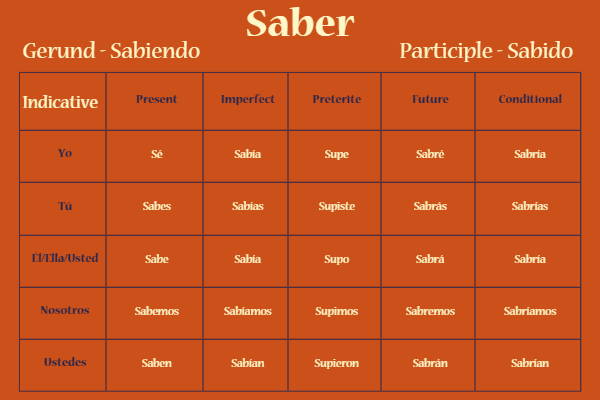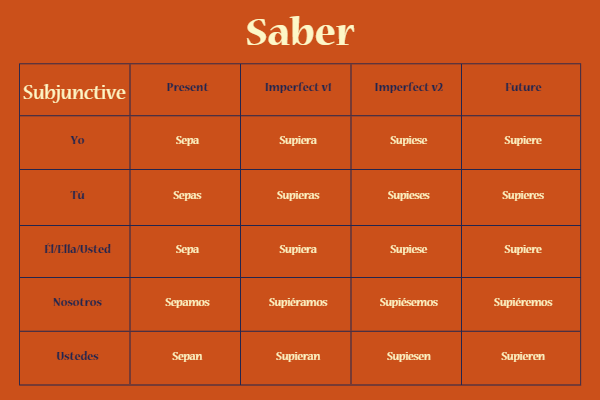Saber or Conocer: Know Which to Use
One of the challenges that often trips up English speakers who are learning Spanish is the difference between the verbs saber and conocer. Both can be translated as ‘to know’, but they are not exact synonyms and have their own distinct uses. Knowing which one to use and how to use it can be tricky to understand. Getting the uses of saber and conocer right will make a big difference to your ability to understand and communicate in Spanish.
Saber (to know)
Saber is the verb used when talking about the knowledge of facts or the possession of skills. It is used for stating that you have information about something or someone. The same verb can also be used for ‘to taste’, or ‘to take the flavor of’ (This is however not a common usage, and it is important to be careful when using it in this sense as it can have intimate and even erotic meaning!).
The verb, is irregular, and undergoes some significant changes in form, particularly in the past tenses.
Transitive vs. Intransitive
To further add complexity, saber is both a transitive and an intransitive verb. Transitive verbs are verbs which need to be placed near to an object to make sense. For example the English verb ‘to borrow’ is transitive because it requires an object to relate to, i.e ‘He borrows the car’. Meanwhile intransitive verbs can be used without an object, such as ‘to swim’, i.e ‘He swam yesterday’. Many verbs in both Spanish and English have both transitive and intransitive forms, however the forms often have slightly different meanings. The best way to judge whether saber should be transitive or intransitive in a sentence is to identify the type of knowledge being described.
Transitive
Transitive verbs require a direct object in the sentence to act upon. For example in the sentence ‘the man buys the newspaper’, the transitive verb ‘to buy’ acts upon the object, the newspaper, causing a transition of its state from not bought to bought. Saber is transitive when used to express knowledge of defined facts or to share that you have specific skills. The skill or fact acts as the object within the sentence.
For example:
Yo sé hablar. - I know how to speak.
Or
Ellos saben el itinerario. - They know the itinerary.
In these cases, hablar is the skill you have and el itinerario is the fact you know about. Both of these function as the direct objects in the sentences.
Intransitive
Saber is intransitive when talking about knowing news about a person or event. As intransitive verbs cannot act independently upon objects, they require some form of preposition or other connector to function correctly if they are being used in a sentance with an object.
For example:
Estoy sorprendido de que no sabes del accidente. - I am surprised you don’t know about the accident.
Or
¿Cuando supieron de ella? - When did they learn about what happened to her?
The prepositions, such as de and del, in the above sentences take the place of ‘about’ in English sentence structure, and connect the verb to the object. If we removed prepositions de or del, the sentences would either cease to make sense or alter the meaning entirely.
Examples of how to use saber
Here are some examples of the different ways saber is commonly used in different tenses and moods.
Sabemos la verdad ahora. - We know the truth now.
Sabían jugar al ajedrez cuando eran niños. - They knew how to play chess when they were children.
Nunca supe sobre el tiempo pasado. - I never knew about the past tense.
Sabrás que hacer. - You will know what to do.
Nunca hemos sabido conjugar. - We have never known how to conjugate.
No sabíamos nada del pasado antes de ver el documental.- We had known nothing about the past before watching the documentary.
Habré sabido la causa durante tres años. - I will have known the cause for three years.
Seria bueno que supieran la verdad. - It would be nice if they knew the truth.
Si supiese en ese momento lo que yo sé ahora. - If I knew at that moment what I know now.
Habría sabido muliplicar, si me hubieras enseñado. - I would have known how to multiply if you had taught me.
Conocer - (To Know)
Conocer is used when expressing knowledge of people and places and also to express familiarity with a subject or with things. In each case the use of the words varies depending on the kind of knowledge or familiarity being described.
Conocer is also an irregular verb, so it is important to pay particular attention to its correct usage.
Conocer and people
When referring to other people, conocer can be used to mean both that you have met someone and that you know that person personally. Usually the difference between these two is only clear from the context.
For example:
Yo conozco a los padres de Juan. - I know Juan’s parents. / I met Juan’s parents.
Yo conocí a los padres de Juan - I met Juan’s parents. / I knew Juan’s parents.
In both cases either meaning is correct, so it is important to understand what you’re wanting to express. Are you wanting to just state the simple fact that you know or have a current relationship with Juan’s parents or that you have met them? (the first example) Or, are you stating that you’ve met his parents in the past or had a relationship with them in the past? (the second example).
It is always necessary to use the personal preposition ‘a’ following the verb conocer when you’re referring to a person, group of people or a named animal, such as a pet (this is not used for wild animals). The preposition always appears after the verb, conocer, and before the person's name.
For example:
No conozco a Julia. - I don’t know Julia.
Conocimos a sus hermanas. - We met her sisters.
Quiero conocer a tus amigos. - I want to meet your friends.
Conocer and places
When using conocer to discuss places, it generally means that you have physically been to that place, rather than ‘knowing about’ its existence without having set foot there.
For example:
¿Conoces Argentina? - Have you been to Argentina?
Despite the literal translation of ‘Do you know Argentina?’, this would generally be asked, and answered, as a query into whether you have been there.
If you wish to ask if someone knows about a place’s existence or about a place in general, you need to use the use of the verb, saber, as you're inquiring about something.
For example:
¿Sabes de España? - Do you know about Spain?
You may find there is regional and even personal variation in how conocer is used with reference to places, but as always context is key to divining the exact intent of the speaker.
Conocer and familiarity
The use of conocer which can be the most difficult to master is when using it to express familiarity with things or with subjects. Again this goes beyond being aware of the existence of something.
For example:
¿Conoces la obra de teatro Yerma? - Do you know the play Yerma?
Rather than asking if the person knows about the play in question, this sentence is asking whether the person has seen or perhaps read the play, whether they are familiar with it. This would be the same for books or films or any other form of media. The same goes for when speaking about subject areas:
Él conocía la filosofía griega antigua. - He knew ancient Greek philosophy.
This sentence implies that he was knowledgeable about ancient Greek philosophy, rather than that he knew that the ancient Greeks had philosophy.
Examples of how to use conocer
Nos conocemos bien. - We know each other well.
Ya conocí a la nueva profesora. - I already met the new professor.
Ellos se conocerán en su primera cita. - They will meet each other on their first date.
Cuando éramos niños no conocíamos a nuestros primos. - When we were children we did not know our cousins.
Me gustaría conocerte.- I would like to meet you.
Es bueno que ellos conozcan la cultura latina. - It is good that they are familiar with Latin culture.
¿Conoces bien los libros de Garcia Márquez? - Are you very familiar with the books by Garcia Márquez?
Mi maestro de arte conoce todas las obras clásicas. - My art teacher knows all the classic paintings.
When using both saber and conocer are correct
In some corner cases it is possible to use the verbs saber and conocer interchangeably without altering the meaning of a sentence. This is mostly the case when talking about abstract or unknown concepts and ideas. An example of this would be when talking about a search for specific knowledge. These cases do not come up often, but they are useful to be aware of.
For example:
Los físicos hicieron los experimentos porque querían saber/conocer sobre el comienzo del universo. - The physicists did the experiments because they wanted to know about the start of the universe.
Ojalá supiera/conociera el significado de la vida. - I wish I knew the meaning of life.
While the differences of saber and conocer can seem complicated and overwhelming, having the ability to differentiate between types of knowledge can soon feel very useful. Becoming confident with the differences is a big step towards mastering Spanish. However, as Spanish is spoken all over the world and has evolved in many different ways, don’t be too surprised if you come across new and unusual uses of saber and conocer.
Is there another Spanish language topic that you are struggling with or would like to read an article about? Let us know at communications@naatikmexico.org. You can find our other Spanish language blogs here.
Sign up below to receive our monthly newsletter with links to all our latest blogs about Spanish and Maya language, Mexican culture, history and cuisine and much much more.
If you would like to take the next step in your language journey, Na’atik offers a unique nonprofit language immersion program, where your Spanish or Maya lessons are enhanced by a homestay experience in the town of Felipe Carrillo Puerto. Sharing meals and spare time with local and Indigenous people makes this a unique opportunity to see authentic Mexico. Online classes are also available. Every visit and online package helps us to provide life changing educational opportunities to local children.Visit our immersion page or contact us on say@naatikmexico.org to find out more.




